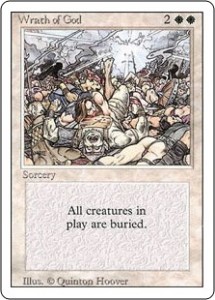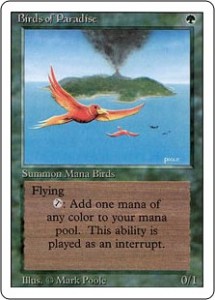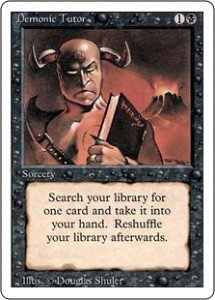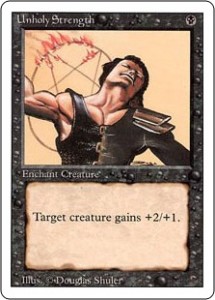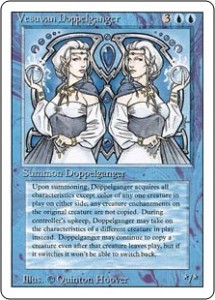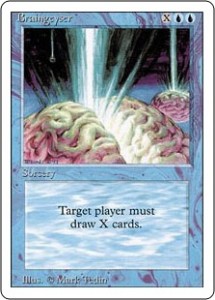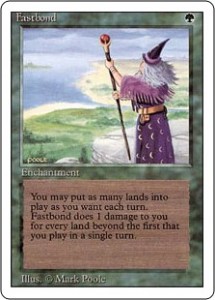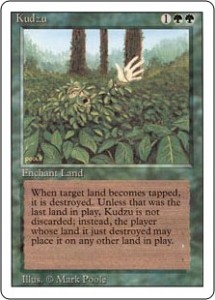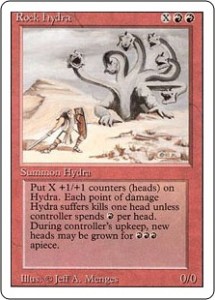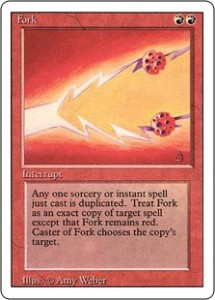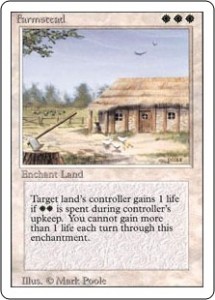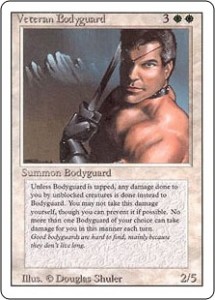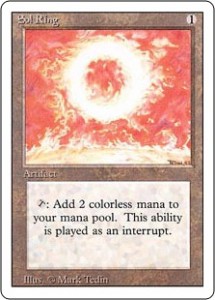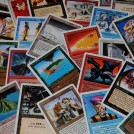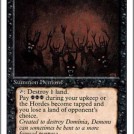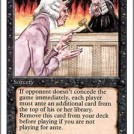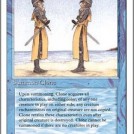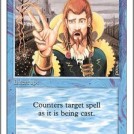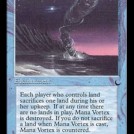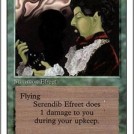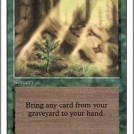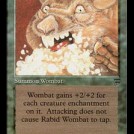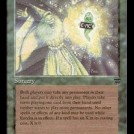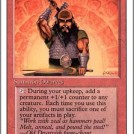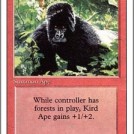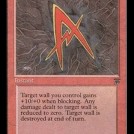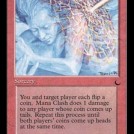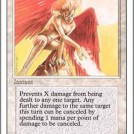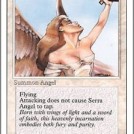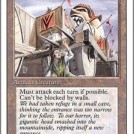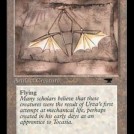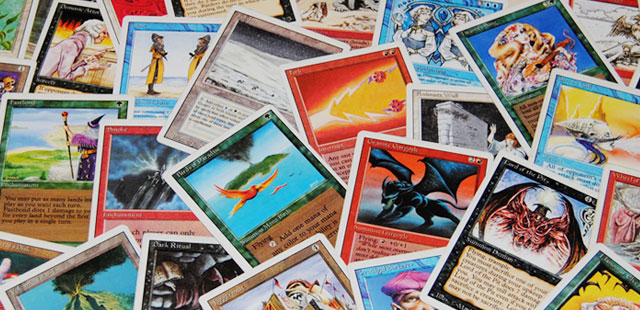
An Introduction to Revised Edition
Magic: The Gathering’s first set with some controversy among players about the cards contained or not contained within the set was Revised Edition. It was the definitive base set replacing Unlimited Edition until it was replaced by Fourth Edition a year later. The set was very similar to the three base sets that preceded it with the exception of the “Power Nine.”
Released in April 1994, Revised or 3rd Edition, is actually the fourth base or core set that Wizards of the Coast produced. It was comprised of 306 total cards; 51 Artifacts, 46 Black cards, 46 Blue cards, 45 Green cards, 25 Lands, 47 Red cards, and 46 White cards. The rarity breakdown was 121 Rare, 95 Uncommon, 75 Common and 15 Basic Lands. It was the last set to contain a higher number of Rare cards than Uncommon or Common.
The art on the cards was the same that had been used before, but this was only the second set released that had white borders, it’s predecessor Unlimited also had white borders, but before that, all base sets and expansions always had black borders. Revised was also four more cards than the Unlimited set, due to some omissions from Unlimited and additions from sets like Arabian Nights and Antiquities.
Revised also had rule changes. The LIFO rule, or “last in first out” was created for this set to help with confusion because of “multiple effects resolve simultaneously unless a conflict arises.” The other change was the elimination of the “Mono,” “Poly,” and “Continuous” artifact qualifiers. This elimination gave way to the tap symbol, that has changed a bit over time.
Revised is full of great cards, that had their last printing in the set, but I will get to them later, because to talk about Revised, you must first talk about omission and there were 9 that caused an immense stir. Revised was the first base set printed that did not include the “Power Nine.” No Ancestral Recall, no Black Lotus, no Mox Emerald, no Mox Jet, no Mox Pearl, no Mox Ruby, no Mox Sapphire, no Time Walk and no Timetwister.
The short answer as to why they were not included in Revised, and have not and probably will not ever be printed again, is because Wizards of the Coast considers them “broken” or overwhelmingly powerful, in layman’s terms. Fair enough, as I do want to focus on Revised and arguing about how “broken” or “unbroken” the Power Nine are, is futile and I won’t go into it here. So back to revised.
The Lands in Revised: Last Gasp for the Dual Lands
Revised was the last set to include “Dual Lands” at least it was until the Masters Edition II* them in 2008 and again in Masters Edition IV* in 2011. There are ten Dual Land; Bandlands, Bayou, Plateau, Savannah, Scrubland, Taiga, Tropical Island, Tundra, Underground Sea and Volcanic Island. Each of these represents two Basic Lands in one and is treated as such. A Bayou is both a Swamp and a Forest.
I’m not sure of the tournament rules now for using Masters Editions*, but back in the day, seeing a Dual Land in your opening draw was simply amazing.
As I said, before the art that was used in Revised was the same art that the card had printed on its in previous editions. As such, at the time of Revised, players had gotten used to the fact that there were only three versions of the basic lands. We got pretty attached to that artwork, which was to be used again in Fourth Edition.
The Color Black in Revised: Goodnight to your “Demonic” Side
Revised Edition was the last base set before Magic started to clean itself up, although it was much more accidental or incidental. Demonic Tutor, Demonic Hordes and Demonic Attorney all made their last stands in Revised, as did, Contract from Below, Sacrifice and part of the artwork in Unholy Strength.
Demonic Tutor is, and in my mind and many others will always be, the best tutor card. It’s two Mana for any one card in your deck, no restrictions. Need a land? Need to complete your combo? Need a creature? It doesn’t matter what you need, you can have it. It’s not part of the Power Nine, but by definition, it is “overwhelmingly powerful,” which is probably why it made it’s last stand in Revised.
Demonic Hordes on the other hand is a fairly well balanced card. For three Colorless and three Black Mana you can summon a 5/5 Demons that TAPS to “Destroy 1 land.” The drawback however is that you must “Pay three Black Mana during your upkeep or the Hordes become tapped and you lose a land of opponent’s choice.” I do have one of these in my “Old Skewl Black” deck, because I really like the card, but having too many will leave you with little Mana for anything else.
Unholy Strength is a Black staple, or it was until Magic 2011, which appears, as of now, to be it’s last printing. Back in the day, your first turn Dark Ritualed hypnotic Specter would be hitting your opponent as a 4/3 because of Unholy Strength. This didn’t change in Fourth Edition either, but the artwork changed. Revised was the last time Unholy Strength’s artwork had a burning pentagram in the background, which is why the Fourth Edition version looks so bland.
The Color Blue in Revised: Copy Me One Last Time
Blue has and will, in my mind, always be about control. Counterspell by itself and in it’s many incarnations is very powerful, as is Control Magic and it’s many iterations, but Revised was the last time until recently that Clone and Vesuvan Doppleganger got to show off their talents.
Clone has since been reprinted and Vesuvan Doppleganger appears in the Masters Edition*, but in 1994 these were two of Blue’s power cards. “Oh, I see you have a Shivan Dragon, that’s nice, now I do too.” Obviously, Blue lost some power when the Power Nine were removed from Revised. No more Ancestral Recall, Time Walk or Timetwister, but it didn’t loose everything. Blue managed to hang on to Braingeyser, which was then lost to time until it was available in Masters Edition IV*.
Braingeyser was as simple as simple could be, for X and two Blue Mana you had a sorcery that allowed you to “Draw X cards or force opponent to draw X cards.” It was a staple of Millstone decks and another way to get to your combo faster. Or in some cases, I’ve even seen it used to win a long game, when the opponent, could only draw two of the three cards required for the spell. I know games don’t last that long anymore, with all the speed in today’s game and I’m sure it’s still a rule, but in case you forgot or were unaware, “If you can’t draw a card when required to do so, you lose the duel immediately.”
Serendib Efreet was a great card overshadowed by a misprint. As a creature, Serendib Efreer is a two Colorless and one Blue Mana costing 3/4 Flyer that “does 1 damage to you during your upkeep,” but during revised it had a green border and was printed with the artwork from the Ifh-Biff Efreet of the Araban Nights Set. Honestly, I always preferred Ifh-Biff over Serendib anyway, but we can all agree that Efreets can be fun.
The Color Green in Revised: Pretty much the Same Old, Same Old
One of the unique facets about the Color Green, in going from Unlimited to Revised, was how little actually changed. Of note there are really only a three cards that made their last stand in Revised; Fastbond, Kudzu, and Regrowth. Other than that, with the exception of the additions from Arabian Nights and Antiquities, Desert Twister and Crumble respectively, Green has been a constant.
Although Green didn’t loose much from Unlimited to Revised or even from Revised to Fourth Edition, the last stand of Fastbond in Revised was glorious. Available in Masters Edition IV*, Fastbond is an enchantment for one Green Mana which states, ” You may put as many lands into play as you want each turn. Fastbond does 1 damage to you for every land beyond the first that you play in a single turn.” This was a great card for dumping all the Mana in your hand for the sake of casting your Shivan Dragon, because let’s face it, Green/Red Decks with Green Mana producers and big Red creatures was a force to be reckoned with back then, if done properly.
Kudzu, on the other hand, was not about giving Mana, but about taking it away. For one Colorless and two Green Mana, you can enchant a land with “When target land becomes tapped, it is destroyed. Unless that was the last land in play, Kudzu is not discarded; instead the player whose land it just destroyed may place it on any other land in play.” It’s very much like a slower Green version of Mana Vortex, in fact that’s exactly what it is, and it can be very fun to play it with an Icy Manipulator.
Regrowth also made is grand last stand in Revised. One Colorless and one Green Mana gave you a sorcery which allowed you to “Bring any card from you graveyard to your hand.” In my humble opinion it was the casting cost that did this card in. If it had been more expensive, say a converted Mana cost of three or four, it probably would have been reprinted in Fourth Edition, if not beyond.
The Color Red in Revised: No More Roc, Rock, Fork
The Color Red had three amazing cards finish their print runs in Revised; Rock hydra, Fork and Kird Ape, along with Roc of Kher Ridges, Sedge Troll, Earthbind and Dwarven Weaponsmith.
The Rock hydra was quite the beast. In Unlimited, when the Moxen and Black Lotus were still in available, you could really get your Hydra up in power more quickly than you could in Revised. It was one of the first X casting cost creatures costing X and two Red Mana. When summoning the Rock hydra you could, “Put X +1/+1 counters (heads) on Hydra. Each point of damage Hydra suffers kills one head unless controller spends one Red Mana per head. During controller’s upkeep, new heads may be grown for three red Mana apiece.” Back then games would last longer, so the ability to regrow heads played into the strategy around this card. I was sad to see it go, although it has since been available in Masters Edition IV*.
And you thought Blue had all the copy spells. Fork was brilliant for many reasons. First, it’s cost, just two Red Nana. Second, it’s not just an Instant, it’s an Interrupt or it was until Interrupts were removed from the game. Third, it has beautiful copy, “Any one sorcery or instant spell just cast is duplicated. Treat Fork as an exact copy of target spell except that Fork remains red. Caster of For chooses the copy’s target,” simple and straight forward.
So let’s contemplate the options… Did you just use your last Lightning Bolt? No worries, this one just costs two Mana. Did your Mana Clash not work out with as much damage as you needed? Fork it. Want to really beef up your Ball Lightning? Blood Lust it and then Fork the Blood Lust. Eureka? Fork it. And lastly, my favorite, Fork a Glyph of Destruction on an wall enchanted with Animate Wall for a +20/+0 boost that attacks!
Not to be outdone but it’s Rare counterparts, Kird Ape, a Common in Revised, was the staple of staples for any Red and Green Deck. In that scenario it’s very nice to be attacking turn two with a 2/3, while you opponent is sitting there with an 0/2 Ornithopter or a 1/1 weenie.
The Color White in Revised: You still have Plenty of Protection
The Color White had a very similar story to that of Green in Revised Edition. It gained a few cards, didn’t loose much and was relatively unchanged for Fourth Edition. Like Green there are a few notable cards that made their last printing in Revised; Farmstead, Guardian Angel, Lance, Resurrection, Reverse Polarity and Veteran Bodyguard.
Farmstead was probably one of the greatest life gain opportunities you could have in a long game. Three White Mana was all you needed to Enchant a Land, from there “Target land’s controller gains 1 life if two White Mana is spent during controller’s upkeep. You cannot gain more than 1 life each turn through this enchantment.” No biggie there, if you have Mana and nothing to spend it on, gain a life. If you have more Mana than need, again gain a life.
White isn’t just about gaining life, it’s also about prevention and Guardian Angel may be one of the best damage prevention cards in the game… If you have the Mana. The shame of this card is that I never really saw it utilized and I, myself, never seemed to draw it when it would have been helpful. “Prevent X damage from being dealt to any one target. Any further damage to the same target this turn can be canceled by spending one Colorless Mana per point of damage to be canceled.” Essentially, if you have a next turn win, this is the card that can help you get there, by making yourself the target.
Lance was really only good for one kind of deck; The Rabid Wombat deck. It’s one White Mana for “Target creature gains first strike,” but as a creature enchantment, it’s also one White Mana for a +2/+2 bonus on your Rabid Wombat. Resurrection was helpful for a cost, so it seemed like a balanced card, that we suspected we’d see in Fourth Edition. Reverse Polarity, an addition from Antiquities, was by all accounts only really useful against Aladdin’s Ring, which was only 4 damage anyway.
Veteran Bodyguard was great if you could buff him with a Holy Strength or two or three. The Bodyguard wasn’t much more than an expensive deterrent against being outnumbered by your opponents army. “Unless Bodyguard is tapped, any damage done to you by unblocked creatures is done instead to Bodyguard. You may not take this damage yourself, though you can prevent it if possible. No more than one Bodyguard of your choice can take damage for you in this manner each turn.” Well, point taken, the card is what it is, a bodyguard.
The Artifacts of Revised: Say Goodbye to your Sol and More…
I’ve already spoken about the loss of the Power Nine, which had a great impact on the Artifacts included in Revised. As such 9 Artifacts were added from Arabian Nights and 10 Artifacts were added from Antiquities.
One Artifact stands alone in importance that made it’s last stand in Revised, until it was reprinted in Commander, and that Artifact is the Sol Ring. Sol Ring was such a staple back in the day, if you weren’t using it in your deck, you weren’t trying. It was one of the first cards I ever owned that was restricted and banned in various tournament formats and who could blame them.
I mean, just think of what could happen if you had four Mana on turn two? Juzam Djinn, Mana Batteries, Dingus Egg, Gauntlet of Might, Icy Manipulator, Knowledge Vault, and Juggernaut, the list goes on and on, plus it speeds up your chances for that Sengir Vampire or Serra Angel.
One of the aforementioned cards was Juggernaut, which was reprinted in Tenth Edition and has since been in circulation with other sets. If you were going for power, Juggernaut was in your deck. But I know a lot of players who didn’t want their cards to dictate their aggressiveness, so they shied away from it. For me, it depended on the deck. Rocket Launcher and Living Wall, also met their doom after Wizards of the Coast stopped printing Revised.
Ante This, Batman!
Ante Cards started to fall by the wayside after Revised. Contract from Below, Darkpact and Demonic Attorney all stopped being printed after Revised and Wizards only added three Ante cards to Fourth Edition from other sets, which were phased out after Fourth Edition anyway.
What We Learned from Revised Edition
There are a few takeaways to be had from Revised. The first was that Wizards of the Coast was trying to draw in more players to sanctioned tournaments by removing the Power Nine, they evened the playing field a bit.
The second was that Wizards had decided that after Revised they would clean Magic: The Gathering’s image as something separate from the occult or devil worshiping. This was done by removing the flaming pentagram from Unholy Strength and no longer printed any of the “Demonic” cards.
Third, Revised was a glimpse into the future. Cards were beginning to be cycled out as new expansions were to be made. The rules tweaked slightly in places, but the word Errata had become commonplace, which is why so many of the card abilities in Fourth Edition are vastly shorter than their Revised Edition or other original printed set counterparts were.
There you are, a whole lot of information on Revised Edition, a set of Magic: The Gathering cards that went out of print in April of 1995 when it was replaced by Fourth Edition.
*Masters Editions are only available for online play.
